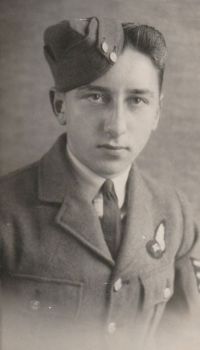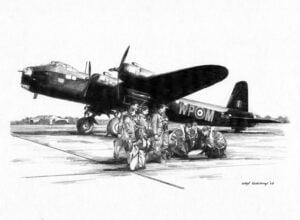Norris | Ivor Henry
- First names
Ivor Henry
- Date of birth
15-10-1923
- Date of death
01-09-1990
- Service number
1315147
- Rank
Sergeant
- Regiment
RAF Volunteer Reserve, 90 Sqdn.

Forword
Overloon War Chronicles includes this biography of Ivor Norris because of his central role in the backstory of the fate of the Stirling BK 718 crew. He too deserves to be remembered along with his crew-mates buried in the Overloon War Cemetery.
Biography
Warrant Officer Ivor Henry Norris (No. 1315147), rear gunner, was a member of the crew of the Stirling III BK718 which was shot down on 4th July 1943, either by Flak88 or Hayo Hermann (luftwaffepilot). They took off at 23.26 on 3rd July 1943 from West Wickham and crashed at Mehlem on the west bank of the Rhine, 10 km SSE of Bonn.

Ivor Norris succeeded in bailing out and landed safely by parachute. He was taken as a Prisoner of War. The rest of the crew is buried at Overloon War Cemetery.
The other crew members are:
Oliver Beard
Robert Freeland
Andrew Patrick Gilmour
Hugh Murray
Robert Charles Platt
Geoffrey Charles Smith
Plane data: Short Stirling III
Serialnr. BK718
Call Sign: WP-M
Unit: 90 Sqdn.
Take off: 11:26 PM West Wickham airfield.
Target: Köln.
Operation: Bombing.
Shot down by FLAK.
Crashed at Bonn-Mehlem, Germany
Family history
Ivor Henry Norris was born in Bristol on 15th October 1923. His parents were John and Lucy Norris (nee Sell) – born 1893 and 1890 respectively. He had a brother, Peter J Norris, born in Bristol in 1921.
Ivor was living with his parents at 89 Church Road, Bristol in September 1939. He was a Junior Clerk in a Drawing Office while his father was a Commercial Traveller in Hardware. His brother was not present.
He was working for the Bristol Aeroplane Company before the war. This was both one of the first and one of the most important British aviation companies, designing and manufacturing both airframes and aircraft engines.
He had joined the RAF Volunteer Reserve by 16th February 1942.
Details of how Ivor came to be with this crew can be found in the extended side-story about the fate of the crew of the Stirling BK718.
As has been seen, he was taken as a prisoner of war after the plane in which he was flying crashed at Mehlem on the west bank of the Rhine on 4th July 1943.
His family had a degree of Jewish ancestry. He underwent interrogation and examination when he was captured. His Jewish background could have resulted in him being sent to a Concentration Camp instead of a Prisoner of War Camp, but thankfully there were no outward signs of his family background which meant he did not suffer this fate.
By July 7th 1943 he was able to write the first of many letters and postcards to his mother and father, but also to his future wife, Gwladys Hughes. He was initially taken to Dulag Luft which was in Oberusel just outside Frankfurt. This is where all aircrew were taken initially for processing and interrogation. He reassures his family that he is fine, that he came down without a scratch and that life in the camp wasn’t too bad. He tells them that the aircraft was shot down by Flak. He had bailed out but did not know about the rest of the crew and hopes they are ok. He also says that the parachute saved his life. He even remembers it is his brother’s birthday and asks his parents to buy a present for him from him. He also asks them to let that “the lads at the B.A.C know that I’m OK & a P.O.W..” He tells Gwladys that he hopes she will wait for him, which she clearly did.
By 16th July 1943 he was in Stalagluft VI as that is when he wrote his first letter home from there. Stalagluft VI was in Heydekrug, which is in current day Lithuania. It was the furthest east of all PoW camps. He was in Lager (Compound A) which was the first one to be built and where all RAF NCOs were taken in July 1943 to join RAF NCOs that had been transferred there from Stalagluft 3 (The Great Escape PoW camp).
Ivor was promoted to Flight Sergeant on 26th July 1943 and then Warrant Officer on 26th July 1944. Apparently, this was standard practice during the war. His parents received a letter from the War Office dated 23th Oct 1944 confirming this.
Ivor’s son, Tony, recalls a story told by his Uncle Peter about Ivor’s time there. In September 1943, there was an attempt at a mass escape from the camp via a tunnel (a bit like the Great Escape). 50 PoWs were chosen to escape. 8 managed to escape but the 9th one was spotted and captured. So there were 41 others stuck in the tunnel. According to Peter, Ivor was one of those stuck in the tunnel. There is a break in his letters home from 6th August to 24th September. He might well have been in the “Cooler”. There is not another long break until December 1944 and 1945.
In July 1944, a lot of the men in Stalagluft VI were moved to Stalag 357 near Torun, Poland due to Russian advances in the east. Here Ivor met Sgt. Bob Trett who had been in Stalgluft V1 but in E Compound. Stalagluft 357 was then relocated in August 1944 to Fallingbostel in Germany. Fallingbostel is between Hannover and Hamburg. This, by other people’s accounts, was not pleasant due to overcrowding and a lack of food.
On April 10th 1945, most Airforce PoWs were marched out of Fallingbostel in a number of columns and headed in the direction of Lubeck. One of these columns was unfortunately strafed by allied planes and about 60 PoWs were killed. The column Ivor was in was not hit however.
On April 17th, Ivor, Bob Trett and two Americans, William Burchill and Lloyd Faddon, decided to escape. They hid out in woods for 3 days and nights and eventually came across British troops. Bob Trett’s account (which he later sent to Ivor and which his son still has) says that it was the 23rd Hussars, though a newspaper cutting says the 11th Hussars.
On April 20th they were taken to Celle and then on April 23rd they were flown to Goch and then on to Brussels. From there they were taken on to RAF Wing in Buckinghamshire and then by coach and train to RAF Cosford. On April 25th Ivor was sent home on leave.
Tony can remember his mother telling him that Ivor weighed just 6 stone when he came home, which would tie in with the awful conditions at Stalag 357 at Fallingbostel. He refused to eat Swede and Turnip for the rest of his life, perhaps because they made up a lot of his diet when he was at Fallingbostel. There are accounts of PoWs picking up the peelings to try and make soup.
In 1948 Ivor married Gwladys M Hughes in Bristol. They had two children: Ian Stuart Norris in 1949 and Anthony Robert Norris in 1954, both in Bristol.
After his return, he said he thought he only survived the crash because, being the rear gunner, he could exit the aircraft by parachute more easily than the others.
After the war he obtained contact details for relatives of his fellow crew members who had died. He is understood to have visited them all. Hugh Murray’s niece can remember when she was a young girl seeing a man in uniform visit her grandmother. She rushed to tell her father that Uncle Hugh was back because he was in uniform. Instead, it was Ivor. Hugh’s mother had never really accepted that Hugh was dead. Perhaps to try to convince her that this was the case, Ivor told her he had been driven past the crash site when taken to the Prisoner of War camp. He said that only the tail was sticking out of the ground – the rest was so badly destroyed that no-one could have survived. However, it is clear from the letters sent to his family from his PoW camp that he did not know the fate of his fellow crew members at that time.
Ivor also visited the graves of his fellow crew members in Overloon, but rarely spoke about the war.
He helped form the Bristol branch of the RAF ex Prisoners of War Association and this is how he and Bob Trett got back in contact after 34 years. A newspaper cutting relates this story, though it suggests it took Dad 4 months to get back home but that does not tally with Bob Trett’s account.
It seems that Ivor resumed his work with B.A.C. In 1956 its Aero Engine business was merged with Armstrong Siddeley to form Bristol Siddeley which in turn was purchased by Rolls-Royce in 1966, who continued to develop and market Bristol-designed engines. He continued to work for Rolls Royce in Bristol until his retirement in 1983.
He and Gwladys then moved to the Isle of Wight.
Ivor Henry Norris died in Southampton on 1st September,1990. He suffered a stroke when volunteering for the National Trust at Mottistone House on the Isle of Wight and was later transferred to Southampton after suffering a further stroke.
Gwladys M Norris was living at Tulgey Wood, Bedbury Lane, Freshwater, Isle of Wight in 2002-6, but moved first to a care home in Barnes, SW London in 2007 and then later to a nursing home. She died on 31/5/2010 in Sunbury, Middlesex.
Ian S. Norris lived in Germany from about 1970/71 as he studied German at University and lived there until he died in 27 May 2020 in Dreieich, Hessen.
Anthony R Norris married Susan J Woodward in Bristol in 1983. They have one child, James Matthew Norris, born in 1990 in Wandsworth London.
Sources and credits
From FindMyPast website: Civil and Parish Birth, Marriage and Death Records; England Census and 1939 Register Records
From Tony Norris: Ivor Norris’ photos, Log Book, Papers relating to flights undertaken by himself and 90 Squadron, Ivor’s letters as a POW and information from Bob Trett
Drawings of the Stirling BK718 made and donated by Ivan Berryman.
Research Elaine Gathercole






